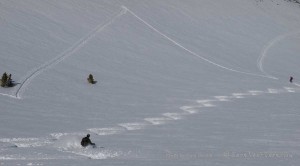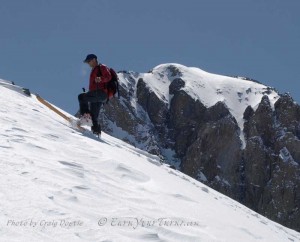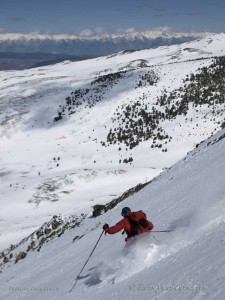There are lots of pieces of specialized gear that are nice to have and can enhance your time adventure skiing. Climbing skins enhance the experience so dramatically that they are practically essential for backcountry skiing. In the right conditions you can ascend a snow covered mountain faster without them (with crampons on frozen corn), but for most days and conditions, climbing skins are as integral to earning your turns as a free heel binding is.

Gil Estrada spoons Robert Blands tracks. Lil' Morrison canyon, Sierra Nevada, April 2010. click to enlarge
Starting next week Climbing Skins will become a regular focus for awhile. The Sierra has been pounded with snow and it’s being roasted into spring corn with all slopes good to go. Several manufacturers have sent samples for review and it will be good to begin a fresh round of comparisons.
It is my hope that this will become a community effort, with my posts establishing a place where you and I can compare notes on each particular skin, informing the backcountry community at large. I’ll begin the process with a first look at each brand and model on their out of the box condition, and their field performance on day one. From there, it will be a matter of documenting their performance over time. Quirks of the tip and tail hardware, how they are holding up after 10 days, 20 days, and special mentions of conditions that caused failures or trouble, like icing up, glopping up, leaving residue, or limits to grip.
It takes time to discern the differences between climbing skins. The glue ages and it’s ability to stick well enough to the bottom of your skis, yet come off when commanded with relative ease, is a tenuous balance of properties that changes over time. Usually the glue looses adhesion, making them come off easier, but sometimes it gets stickier and leaves a residue of goo.
Other items only become apparent over time as well, and via direct comparison to other skins. The exact same conditions are rare between days. Similarities certainly exist, but comparing the grip on a powder day to a day of breakable crust, or corn is just as silly as comparing the glide on different days. You can only compare performance in like conditions, and the best way to achieve that is to use an unmatched pair of skins so you can distinguish differences on the same day in the same conditions. Even then, I’ve found it takes a few days of slight variations in the conditions with the same mismatched pair to see consistencies. Maybe they both ice up in similar conditions, but one always ices first, or more, or delivers a little bit more glide. Grip is usually equal, but on certain aspects, or conditions, again one may edge out the other and this would only be distinguishable by using mismatched pairs.
Even this method has its limits. That’s where you come in. When a whole bunch of people chime in, over time we will start to see consistencies that no single person can see comparing mismatched pairs. Like certain brands do better in the Rockies than the Cascades than the Selkirks than the Alps for different characteristics, in different climates. By adding your experience those trends may come to light.
If you’re up for it, make some mental notes on how your climbing skins are working over the next few weeks and when I write about your brand and model let us know what you’ve been noticing.
Until then, it’s the weekend. Go earn some turns.



1 pings